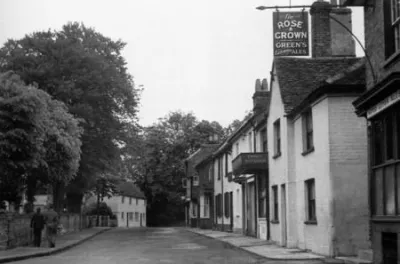Abbots Langley, shown here in the 1950s, has three links to the Whitechapel Murders.
The Jack the Ripper murders
An Abbots Langley detective, and the Leavesden Asylum


In the late Victorian era, London was rocked by a series of gory murders. The perpetrator would never be caught, but he would achieve worldwide infamy under the name Jack the Ripper.
This moniker came from a letter addressed to the police, written in red ink and claiming to be from the murderer.
The police maintained that it was a hoax by a local journalist. Whoever wrote the letter, the name 'Jack the Ripper' gained worldwide attention and so became the first serial killer case to create a global media frenzy.
Between April 1888 and February 1891, 11 women were murdered in Whitechapel. Five of these, known as 'the canonical five', are attributed to Jack the Ripper.
The fourth victim, Catherine Eddowes, was murdered in Mitre Square. The same night, about an hour before Eddowes was found, the body of prostitute Elizabeth Stride was discovered in Dutfield’s Yard, just minutes after she had been killed.
On duty that night was Hertfordshire-born Detective Constable Daniel Halse. Halse was baptised at Bovingdon Church and grew up in Abbots Langley. Vicars of both Abbots and Kings Langley gave Halse good character references, enabling him to join the City of London Police in 1863.
In the early hours of the morning on Saturday, September 30, 1888, Halse was with two colleagues near Aldgate Church when the news reached them that a woman had been murdered in Mitre Square. They rushed to the scene of the crime. One look at the body confirmed that she had died at the hands of Jack the Ripper.
Halse gave instructions for the neighbourhood to be searched. Eddowes’s corpse was taken to the morgue while Halse questioned any men he came across in the surrounding area. His enquiries resulted in no promising leads.
He was present at the examination of Eddowes’s body and he noticed that part of her apron was missing. The scrap of fabric was found the same night in the doorway of Wentworth Dwellings, Whitechapel. This is the only tangible clue ever to be found in connection with any of the murders. It was assumed that the killer had used it to wipe his hands and possibly his knife after he made his escape.
On the wall beside the spot where the apron was found, Halse and his colleagues discovered that some words had been chalked on the black wall. The message, which became known as the Goulston Street Graffito, read, ‘The Juwes are not the men that will be blamed for nothing’.
Halse ordered that the words be photographed, but dawn was fast approaching and the police feared that if the message was seen it could lead to riots and violence against the large Jewish population of East London. The police commissioner took the precaution of ordering the whole message to be rubbed out.
The Metropolitan Police received much criticism for failing to catch the killer. Where before they had been regarded as one of the best forces in the world, now there was incredulity that one man was able to deceive them so efficiently.
The most likely suspect for the murders is Aaron Kosminski, who suffered from aural and visual hallucinations. In 1894 he was committed to Leavesden Asylum in Abbots Langley, where he lived for 25 years until his death in 1919.
Another suspect for the murders was also a patient at Leavesden Asylum. In October 1888, a letter appeared in the Daily Telegraph signed by ‘X of St Albans’. He wrote that a lunatic had escaped from Leavesden Asylum the previous year and had since evaded capture. X thought that this person was the Whitechapel murderer.
The lunatic in question was a doctor named Macdonald. While taking outdoor exercise with other patients, he escaped the asylum and fled into Bricket Wood. He was seen for the last time near Mount Pleasant.
A man matching the description of the Ripper that was based upon possible sightings was arrested in Rickmansworth. However, the man was merely charged with being drunk and disorderly.
Daniel Halse retired from the police force in 1891, the year of the final murder. Most historians assume that the crimes stopped because of the culprit’s death, imprisonment or emigration. The identity of Jack the Ripper was as much a mystery to Halse then as it remains to us today.
Article taken from the Watford Observer Nostalgia Series by Kelly Pells
Verified by Martin Brookes, Chairman of Leavesden Hospital History Association http://www.leavesdenhospital.o...
Reproduced courtesy of The Watford Observer